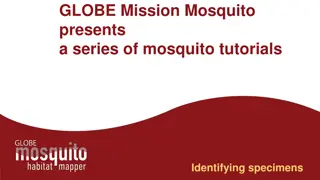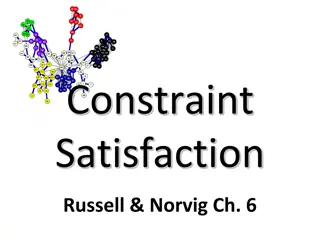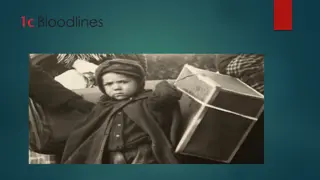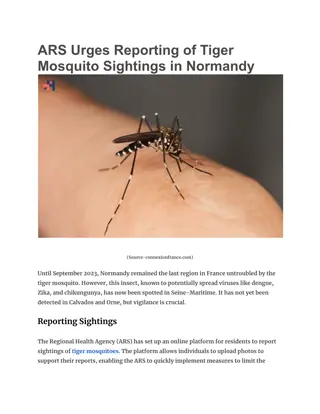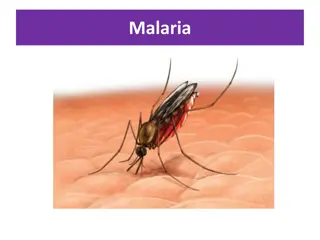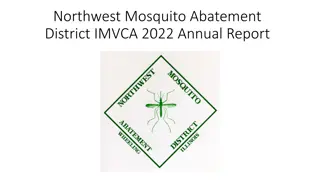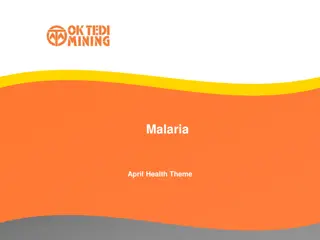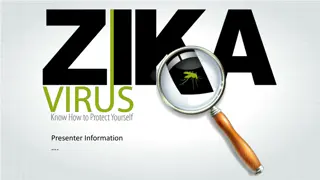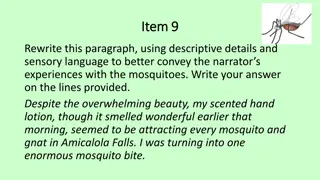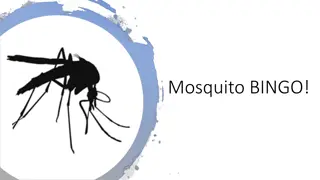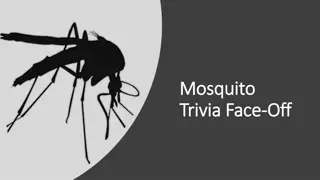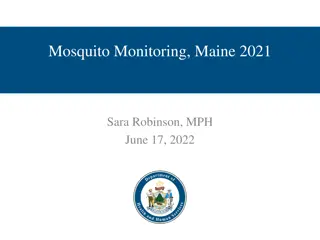Investigating Mosquito Attractants for Effective Trapping in Queens
Mosquitoes are vectors for spreading diseases, prompting a study to test the effectiveness of various attractants in trapping them. Results indicate carbon dioxide and lights are effective attractants, while KCl did not attract mosquitoes. The study aims to develop targeted traps for efficient mosquito control.
Download Presentation

Please find below an Image/Link to download the presentation.
The content on the website is provided AS IS for your information and personal use only. It may not be sold, licensed, or shared on other websites without obtaining consent from the author.If you encounter any issues during the download, it is possible that the publisher has removed the file from their server.
You are allowed to download the files provided on this website for personal or commercial use, subject to the condition that they are used lawfully. All files are the property of their respective owners.
The content on the website is provided AS IS for your information and personal use only. It may not be sold, licensed, or shared on other websites without obtaining consent from the author.
E N D
Presentation Transcript
Abstract Mosquitoes rapidly spread vector-borne illnesses, including malaria, the West Nile virus, and the Zika virus. Among 3,500 species of mosquitoes, 175 species reside in the US. This study tests the effectivity of five different types of mosquito attractants, including blue or violet LED lights, KCl, seltzer water, and a sugar and yeast solution. Traps were set up in two different locations in Queens. Trapped insects were documented and identified by DNA Barcoding using CO1 sequence. The results further showed that carbon dioxide and lights were effective attractants to mosquitoes. The sugar and yeast traps caught the largest variety of organisms. Out of all the insects trapped, the most common was Aedes albopictus (Asian Tiger Mosquito) and Drosophila Suzukii (spotted wing drosophila). Interestingly, KCl, a major component of sweat, did not attract any mosquitoes. This suggests that mosquitoes may be attracted to a different component of sweat, instead. In the future, we hope to develop traps that could target the mosquitoes in one particular area in order to catch the pests more effectively. Purpose To investigate the species caught by different mosquito attractants Could potentially lead to the development of simple and inexpensive traps Introduction Mosquitoes Culex, Anopheles, & Aedes are most common species Females live 2-4 weeks and begin feeding on blood (to produce up to 1000 eggs) ~2 days after reaching adulthood Eggs are laid on stagnant water surface during warm seasons and can stay dormant for 10 to 15 years The female mosquito sucks blood using her labrum, as her saliva is injected into the host s tissue (Life Science, 2012) Mosquitoes are also well known for carrying and spreading diseases such as malaria, yellow fever, and dengue fever, vertical transmission in mosquitoes may occur West Nile virus is transmitted by Culex mosquitoes (Life Science, 2012) http://www.open.edu/openlearncreate/pluginfile.php /4704/mod_oucontent/oucontent/138/none/none/hyg _env_health_session6_fig2.jpg harmful A female mosquito in flight. https://static1.squarespace.com/static/53569847e4b 007661e348fc0/t/54012845e4b096fd0b9b16e3/140 9362057865/mosquito+in+flight.jpg?format=1500w Carbon Dioxide Mosquitoes are extremely attracted to carbon dioxide (CO2) Companies like Mosquito Magnet and Koolatron have developed traps that lure mosquitoes (Mosquito World, 2017) Although mosquitoes detect hosts using heat and CO2, the attractant is so strong that even dry ice will attract them (Newhouse, et al., 1966) using CO2 Molecular structure of dry ice. http://www1.lsbu.ac.uk/water/images/co2_hydration.gif Others Blue LED lights have been found to be the most efficient type of light that could be used (Newhouse, 1966) Red and yellow lights are known to have no effect or at times even repel mosquitoes (Montez de Oca, 2016) KCl is a major component in human sweat It is greater than all the other chlorides found in human sweat Blue LED light trap in the yard.
Method Insert the top part of the bottle into the bottom of the bottle and gentle duct tape the together. (Figure 1.) Add attractants to the traps according to Table 1. All liquids will use 60 mL of liquid. Cut a 2-liter plastic bottle 20 cm from the bottom and twist the bottle cap off. Obtain materials, label all traps with group names and attractants. two parts Use forceps to transfer each trapped mosquito from the trap into a bag. Take photographs from 3 different views next to a quarter. Save all photos and store all specimen in bags at - 20o C for at least 24 hours. Isolate DNA and perform PCR according to standard procedures. Make Traps accordingly to Table 1. Table 2. Table 1. Traps ID Number Scientific Name Common Name 1. Weigh 1.8 g of KCl and add it into the labeled bottle. Add 1.5 L of deionized water into the bottle to create 16 mM concentration. Add 60 mL of Kl solution to the trap. Potassium Chloride PFF-002 Aedes Albopictus Asian tiger mosquito Interpret data using DNA subway and create charts using excel. 2. PFF-003 Drosophila Suzukii Spotted wing drosophila 3. 1. Using a graduated cylinder, transfer 60 mL of seltzer water into the trap. Seltzer Water PFF-005 Coboldia Fuscipes Fly PFF-006 Drosophila Suzukii Spotted wing drosophila 1. Measure 7 g of yeast and add 43 g of sugar into weighing boat. Put sugar and yeast into trap. Add 60 mL of water into trap. Sugar and Yeast PFF-008 Drosophila Repleta Dark eyed fruit fly 2. 3. PFF-009 Calliphora Vicina Blue bottle fly 1. Place 2 1. volt batteries and place next to each other. Connect LED lights with 2 electric wires. Place other side of wires onto batteries Place into trap. LED Lights PFF-011 Drosophila Suzukii Spotted wing drosophila 2. 3. PFF-013 Aedes Albopictus Asian tiger mosquito Figure 1. Mosquito Trap Average Species Trapped by Different Attractants Amount of Organisms Trapped by Different Attractants 12 Amount of Organisms Trapped Amount of Organisms Trapped 45 10 40 35 8 30 6 25 20 4 15 10 2 5 0 0 20 cm Light Sugar and Yeast Seltzer Attractants KCl Control Light Sugar and Yeast Seltzer KCl Control Attractants Aedes Albopictus Calliphora Vicina Calboldia Fuscipes Drosohilla Suzukii Drosohilla Repleta Figure 2. Amount of Sequenced Organisms Out of all the insects trapped, the most common were Aedes Albopictus (Asian Tiger Mosquito) and Drosophila Susukii (Spotted wing Drosophila). It can be concluded that the sugar and yeast traps used in this experiment caught a greater variety of insects compared to the other traps. Figure 3. Amount of Organisms Trapped by Different Attractants Based on the results, the most effective attractant was sugar and yeast because it trapped the most organisms. The least effective attractant, KCl, did not trap any organisms. Since no organisms were trapped by the control, the results are more accurate. Figure 4. The ML Phylogenic Tree From Sugar and Yeast Trap The tree shows how genetically distant many of the four individual species caught with the Sugar and Yeast Trap. The Calliphora Vicina (Bluebottle blowfly) evolved a separate branch because it lacks genetic relations to the other species. Figure 5. NJ Phylogenetic Tree from Sugar and Yeast Trap Based on distances for COI DNA sequences from the four individual species, three out of four of the species are closely related. This could suggest this trap is more effective for catching Drosophila susukii (Fruit fly). Figure 6. ML Phylogenetic Tree From the Light Traps The tree shows how genetically far apart many of the four individuals species caught with the Light Trap. Aedes Albopictus (Asian tiger mosquito)evolved a separate branch because it lacks genetic relations to the other species. Figure 7. NJ Phylogenetic Tree from Light Trap Based on distances for COI DNA sequences from four individual species, Coboldia Fuscipes (fly)evolved a separate branch because it lacks genetic relations to the other species. Two of the insects were Aedes Albopictus (Asian Tiger Mosquitoes). Figure 8. Alignment of the samples Samples were utilized as well as BLAST results with the least mismatch scores.
Discussion The CO2 and light traps were both effective attractants Larger sample size is needed to validate the experiment Traps should be placed at more than 5 different locations in long island The samples were collected in the fall. Summer is a better season for sample collection Sugar-yeast traps not only produce CO2, but also produce odor, which may attract insects other than mosquitoes. Not all the species were barcoded. Some were identified by observation, which may cause errors. Gel electrophoresis of PCR results. Conclusion This experiment further showed that carbon dioxide and lights were effective attractants to mosquitoes The sugar and yeast traps caught the largest variety of organisms Out of all the insects trapped, the most common was Aedes albopictus (Asian Tiger Drosophila Suzukii (spotted wing drosophila) Culex, northern house mosquito,was not caught in the experiment Mosquito) and Future Work DNA in the micro-centrifuge Combine carbon dioxide and light in one trap Try to use a black tape that will stay on the trap so the light only comes out of the top Go to different parks around Queens to catch a more diverse sample Take more samples sequencing Conduct another trial for DNA Mosquito caught from light trap. Acknowledgements Dr. L. Wang Dr. J. Cohen Mrs. N. Jaipershad Mr. Z. Liang Dr. R.X. Lin Mrs. R. DiPietro Dr. D. Marmor Mrs. C. Rastetter Mr. R.M. Ally DNA Barcoding Long Island Francis Lewis High School References Schwartz, I. L., J. H. Thaysen, 1956. Excretion of sodium and potassium in human sweat. The Journal of clinical investigation, 35 (1): 114-120. Hadler, N. M., J. R. Gill, J. D. Gardener, 1972. Impaired renal tubular secretion of potassium, elevated sweat sodium chloride concentration and plasma inhibition of erythrocyte sodium out flux as complications of systemic lupus erythematosus. Arthritis & Rheumatology, 15 (5): 515-523. Thomas, C. J., A. Callaghan, 1999. The use of garlic (Alliumsativa) and lemon peel (Citrus limom) extracts as Culex pipiens larvacides: Persistence and interaction with an organophosphate resistance mechanism. Chemosphere, 39 (14): 2489- 2496. Life Science Staff (August 17 2012). 5 Things You Need to Know About West Nile Virus. Life Science, Received from https://livescience.com/22491-5-things-you- need-to-know-about-west-nile-virus.html Montes de oca, (May 19, 2016), Do LED lights Attract bugs. Mosquito Trap Reviews. (n.d.). Retrieved August 30, 2017, from Patel, H. [Hilten Patel] (2013, April 01). Mosquito Trap. Retrieved August 30, 2017, from https://www.youtube.com/watch?v=pNjyLRQutXs.



